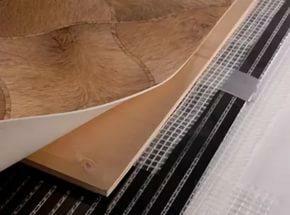 Set a warm floor under the film-type linoleum is simple and it does not need a lot of time creating comfort and warmth in the apartment or private home, budget option may become warm floor under the linoleum. Such coverage can solve problems with central heating in the autumn period and add comfort in a private house. All the work can be done independently, not using the services of professionals.
Set a warm floor under the film-type linoleum is simple and it does not need a lot of time creating comfort and warmth in the apartment or private home, budget option may become warm floor under the linoleum. Such coverage can solve problems with central heating in the autumn period and add comfort in a private house. All the work can be done independently, not using the services of professionals.
-
- Linoleum for underfloor
- Installation work: Warm electric floor beneath linoleum
- How do Infrared warm floor under the linoleum
- Linoleum for warm water floor:
- installation process What a warm floor beneath linoleumWhat better
- use warm floor under the linoleum( video)
linoleum for underfloor
linoleum remained popular thanks coated affordable price and easy stacking, whichAny person can easily carry out. In an effort to make a comfortable and cozy place of residence, many people are thinking about creating warm floors.
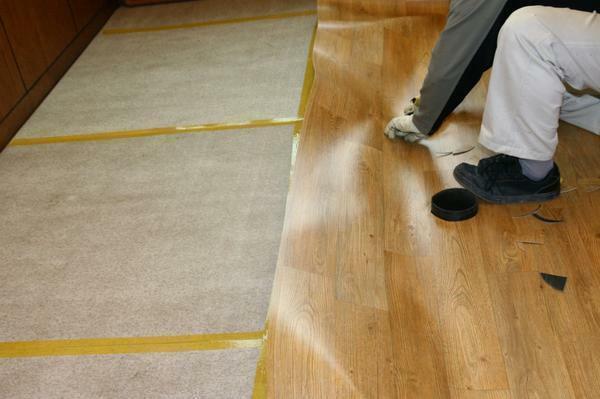 Linoleum - a thin vinyl covering, in which structure is dominated by the chemical components
Linoleum - a thin vinyl covering, in which structure is dominated by the chemical components
Before starting work, it is worth thinking about the finish. For warm floors rubber rubber linoleum on a rubber base is not suitable, since it does not tolerate temperature changes.
Coating with a heat-insulating base will not allow a good heat transfer, reducing the efficiency of heating. Vinyl material will cause an unpleasant odor when heated.
Glyftal linoleum on a fabric basis, does not tolerate heat and will lose shape after a short period of time. Marmoleum - an ideal option for a warm floor, although it is somewhat more expensive. The coating contains natural ingredients. When heated, unpleasant odors and harmful substances are not released.
Among the advantages of Marmoleum are:
- Durability;
- Not static;
- Environmentally friendly;
- Strain resistance;
- Color preservation under ultraviolet light.
The alternative is vinyl linoleum. At purchase it is necessary to pay attention to the information on packing where the maximum temperature mode of operation will be specified.
It's worth noting that Marmoleum can not be heated more than 27 degrees, otherwise it will lose shape and become fractured. Vinyl during heating for some time will exude a synthetic odor, exceeding the temperature of 29 degrees will cause the material to swell.
When installing a warm floor, you need to purchase a temperature controller that will monitor the temperature of the floor.
mounting operation: warm electric linoleum floor under
Underfloor heating systems operating on electricity separated into infrared and electrically.
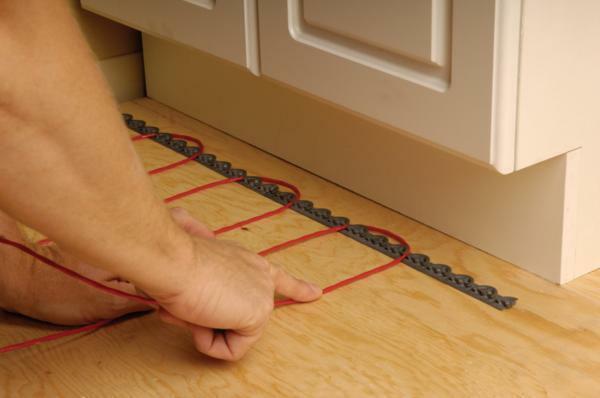 Electric floor heating is not considered to be cheaper to operate because it is like a branch of the heating system at home
Electric floor heating is not considered to be cheaper to operate because it is like a branch of the heating system at home
Installation of electric floor starts with a plan. It should be noted that the heating elements should not be placed under massive furniture. In places where batteries pass, it is not advisable to conduct insulation.
Stages of installation work for the installation of electrical cables:
- Preparation of the floor, dismantling of the old screed, garbage collection.
- Installation of thermostat.
- Laying thermal insulation on the entire surface of the floor, overlapping or fastening with adhesive tape.
- The damper tape must be placed around the perimeter, glued to the walls, when heated, it compensates for the expansion.
- Put the reinforced mesh, which will serve as a fastener for the cable.
- The installation starts from the location of the thermostat.
- The cable is laid with a snake, avoiding intersections. Fasten with clamps or wire to the reinforcing mesh. When working with a cable, it is necessary to cover the decomposed contour with plywood sheets to avoid damage to it.
- After the end of the circuit, the mounting ends of the heating section must be taken out to the thermostat.
- install and fix the temperature sensor on the positioning surface in the region 50 - 60 cm.
- After installation check circuit heating.
- Make a screed floor with cement mortar is not more than 3-4 cm.
for drying the surface will take a few days and the floor is ready for laying linoleum.
How to infrared Heated floor under linoleum
Infrared Heated floor is formed of a special film, which is connected to the mains and it produces a heating surface. This system has gained universal popularity.
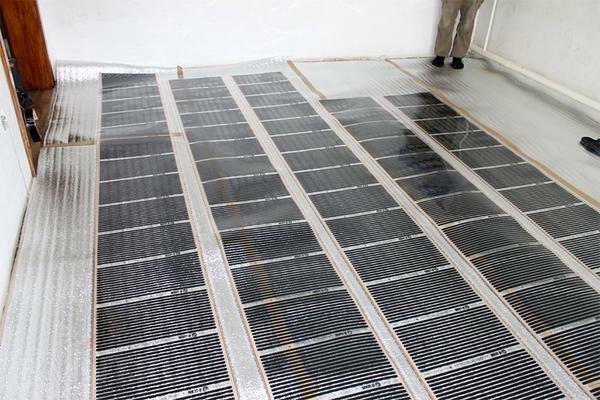 Stack infrared membrane under linoleum floor heating - is at least economically justified
Stack infrared membrane under linoleum floor heating - is at least economically justified
material is easy to apply and can be installed in any room dry, without the additional screed. This allows you to significantly speed up the installation work.
Such floors can be made on their own without resorting to the services of professionals. A higher price and a fear of getting moisture on the material are the main drawbacks of the infrared element. Therefore, such an element is not desirable to use in bathrooms and kitchens. Infrared flooring can be damaged by falling heavy objects.
first produce heating system calculation:
- Find useful area of the room, except for space heating appliances and furniture;
- Then it is multiplied by the power of the heating material;
- With the figure you can safely go for a purchase.
Before starting work, it is necessary to remove the old coating, with an unevenness, make an additional screed. Next, lay a layer of insulation and cover with foil or penofolom. The film heating element is neatly cut at the marks indicated by the manufacturer. Seats are isolated with adhesive tape. Pieces are laid according to a previously thought out scheme. The sensor is mounted and connected to the thermostat. Attach the film strips using electrically conductive tape. Check the power and operation of the system. The final stage is the laying of linoleum.
In some cases, the surface is covered with plywood to prevent damage to the film.
Linoleum Floor for warm water: mounting process
Warm water floor has a more complex structure. It is used mainly for tiling or laminate, but linoleum is also allowed.
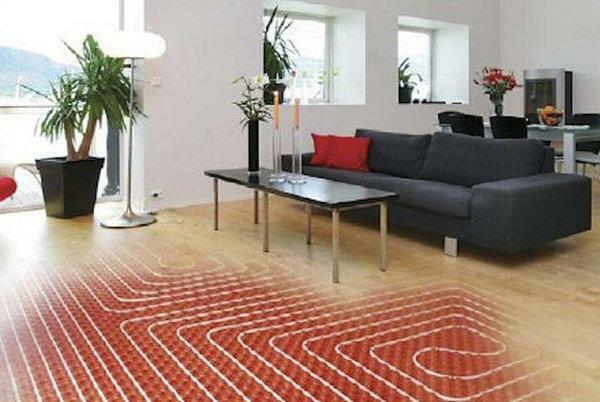 If the installation of the system, and cover is made correctly, radiant floor heating for linoleum - a great choice for home
If the installation of the system, and cover is made correctly, radiant floor heating for linoleum - a great choice for home
There are several methods of water heating laying:
- Screed of concrete, which is poured pipes;
- Pipe laying in special grooves;
- Stacking elements in wooden trenches, more often used for houses made of wood.
Any of the options is more expensive compared to electric heating. Although during operation such a coating becomes more economical in terms of energy resources.
For installation of floor heating is necessary to make the calculation of the number of tubes, buy pot, and mixing unit, as well as connecting fittings and circulation pump.
Installation of the system starts with the boiler. Then prepare the surface for laying the contour.
Assemble the water floor from different layers:
- Waterproofing;
- A damper belt is run around the perimeter;
- Heater;
- Reinforcing mesh for fastening pipes;
- Heating pipes;
- Screw;
- Finish.
The thickness of the common layer reaches 20 cm. Laying of pipes is made by a snake or snail. For concrete finishing filling, reinforcing mesh is used. Heated floor when laying linoleum is only necessary to 25-26 degrees.
Which warm floor for linoleum is better
The warm floor has many advantages, allowing evenly to distribute heat without drying the air, increasing the heat efficiency of the building, freeing up the use of additional heating devices.
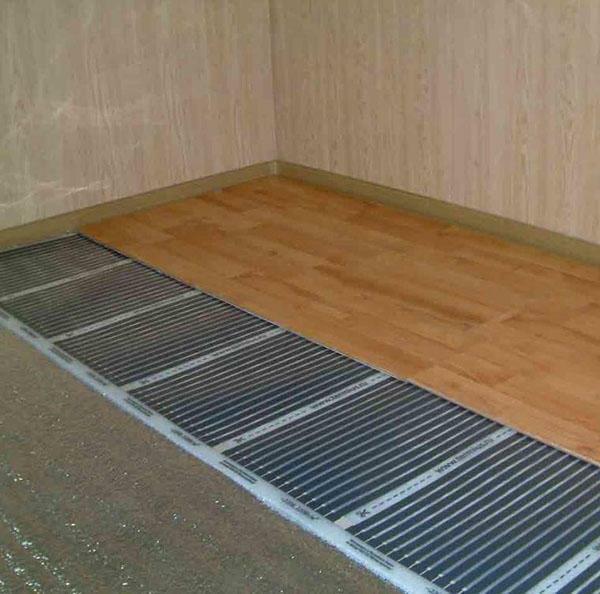 For floor installation, almost any floor covering is suitable, including linoleum
For floor installation, almost any floor covering is suitable, including linoleum
Linoleum on a warm field reduces the heat transfer of the installation. For example, with electric heating, the efficiency is reduced by 25%, in comparison with tiles or parquet.
When laying linoleum on warm elements, you need to pay attention to the thickness of the material and the substrate. It is better to use a thin linoleum with high temperature characteristics.
For water heating, higher temperatures can be used, therefore in private houses, with the main source of heating, linoleum laying on warm floors is impractical.
In multi-apartment buildings, the modern approach to the solution will be infrared flooring for linoleum. The film spends a minimum of electricity, and the heat transfer of the linoleum laid on it will reach 90%, since radiation is much better heated by thick materials. With water and electric heating, the heat transfer will be much lower. One drawback is the high cost of material that will pay off in the process of exploitation.
How to use a warm floor for linoleum( video)
Installing linoleum on a warm floor is an economical and simple solution to the problem that will allow you to enjoy coziness and comfort in the cold months.


